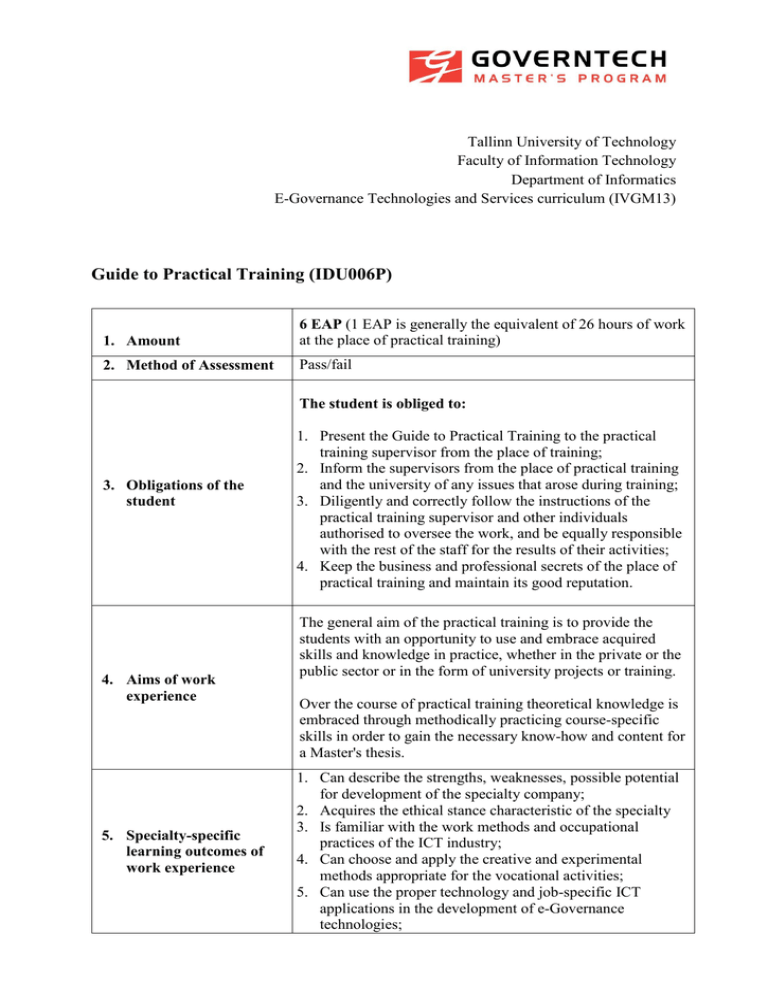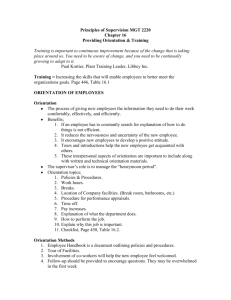Guide to Practical Training (IDU006P) - e
advertisement

Tallinn University of Technology Faculty of Information Technology Department of Informatics E-Governance Technologies and Services curriculum (IVGM13) Guide to Practical Training (IDU006P) 1. Amount 6 EAP (1 EAP is generally the equivalent of 26 hours of work at the place of practical training) 2. Method of Assessment Pass/fail The student is obliged to: 3. Obligations of the student 4. Aims of work experience 5. Specialty-specific learning outcomes of work experience 1. Present the Guide to Practical Training to the practical training supervisor from the place of training; 2. Inform the supervisors from the place of practical training and the university of any issues that arose during training; 3. Diligently and correctly follow the instructions of the practical training supervisor and other individuals authorised to oversee the work, and be equally responsible with the rest of the staff for the results of their activities; 4. Keep the business and professional secrets of the place of practical training and maintain its good reputation. The general aim of the practical training is to provide the students with an opportunity to use and embrace acquired skills and knowledge in practice, whether in the private or the public sector or in the form of university projects or training. Over the course of practical training theoretical knowledge is embraced through methodically practicing course-specific skills in order to gain the necessary know-how and content for a Master's thesis. 1. Can describe the strengths, weaknesses, possible potential for development of the specialty company; 2. Acquires the ethical stance characteristic of the specialty 3. Is familiar with the work methods and occupational practices of the ICT industry; 4. Can choose and apply the creative and experimental methods appropriate for the vocational activities; 5. Can use the proper technology and job-specific ICT applications in the development of e-Governance technologies; 6. Can initiate and complete projects related to the development of the state infrastructure; 7. Can impart occupational knowledge and skills 6. Work experience evaluation criteria In accordance with the aims and the learning outcomes of practical training and the tasks set by the training supervisor compile a Practical Training Report, in which analyse both personal performance and development perspectives. TUT Study Regulations §13 regulates the general administration of work experience. 7. Administration and assessment of work experience 6. Practical Training Report 1. Generally the students themselves find a place of practical training. If necessary, training curators, TUT careers services and, in the case of training abroad, the department of international relations will assist with finding a place. 2. The amount of subject credits of the work experience is set by the curriculum. 3. The tasks of practical training must support achieving the learning outcomes set for the work experience subject. If questions arise, one ought to consult with the practice curator of one's specialty. 4. In the case of training abroad with the Erasmus programme, the agreed upon procedural rules are followed. 5. In order for the practical training to count, the student must submit a formal application to the practice curator of their specialty in ÕIS (applications -˃ application for training credit). Add the Evaluation Form of the Practical Training supervisor and the Practical Training Report to the application. … is an evaluating summary of what was gained during practical training and of the personal development of the trainee. When compiling the report, it is advised to: 1. Structure the report according to the guidelines fixed in point 7 of the this guide; 2. Follow the requirements in the formatting guidelines of the faculty for written coursework when formatting the coursework. 3. Assess the purposefulness and the productivity of practical training; 4. Assess themselves; 5. Give an overview of the practical training process and analyse the fulfilment of the aims of practical training. 7. Structure of the Practical Training Report 7. Training contract 1. Introduction 1.1. Establishing the aims and the tasks of practical training; 1.2. The chosen place(s) of practical training – selection criteria. 2. Analysis of the activities of the place of practical training 2.1. A description of the place of practical training: field of work, main offered products and services, structure, number of employees, market position in Estonia and in a wider context; 2.2. The description and organisation of the work process. 2.3. A description of the work period of the trainee. 3. Overview of the practical training process (including self-analysis) 3.1. Evaluation of preparation: the level of theoretical and practical preparation for training – strengths and weaknesses; 3.2. Evaluation of performance: a list of tasks and activities performed during training and an analysis of the performance of the work tasks; 3.3. Name what you learned over the course of practical training. An evaluation of new knowledge and skills. 4. Evaluation of the place of practical training: 4.1. An evaluation of the process and means of supervision; 4.2. The compatibility of the chosen place of training with fulfilling the aims of the practical training course. 5. Summary of practical training 5.1. An overview of the practical training process and results. 5.2. Evaluate the results and the fulfilment of the aims of practical training according to the aims of practical training. 6. Appendixes 6.1. Mandatory appendix: an Evaluation Form of the Practical Training Supervisor 6.2. Contracts, schemes, figures, tables, photos, copies of necessary documents. 1. If necessary, it is possible to form a three-way contract between the trainee, the place of practical training and a representative of the university (as a rule, the university is represented by the director of the institute connected to the specialty); 2. Generally the place of practical training will form a two-way work or training contract with the trainee; 3. Remunerating the trainee for their work is decided by the place of training (unless intellectual property is created).
